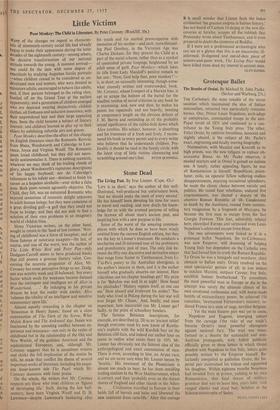Stone Dead
The Living Past. By Ivar Lissner. (Cape, 42s.) 'LIFE is so short,' says the author of this well- illustrated, well-produced but unfortunate book, 'that we should make the most of every second.' He has himself been devoting his time for years to travel and reading, and now distils his know- ledge for us with the avowed purpose of telling the layman all about man's ancient past, and inspiring him with a new purpose in life.
Some of the worst of the amazing common- places with which he does so have been wisely omitted from the current English edition, but they are the key to Lissner's treatment. He conducts a saccharine and ill-informed tour of the prehistoric and protohistoric past of man. The only link be- tween the fifty-one discursive and derivative essays that range from Sumer to Tianhuanaco, from Li- T'ai-Po's poetry to the Australian aborigines, is the author's interest in them, and it is the author himself who gradually absorbs our interest. How ridiculous can his chapter headings get? My prize is for 'Babylon was well lit at night.' How banal his platitudes? 'History repeats itself, as one can see.' How absurd and irrelevant his asides? 'No- body who lived in Peking during the last war will ever forget Mr. Chuan.' And, finally, and most important, how inaccurate can Mr. Lissner get? Sadly, to the point of schoolboy howlers.
The famous Behistun inscriptions, for example, are described (p. 28) as an 'ancient tablet' though everyone must by now know of Rawlin- son's exploits with the wild Kurdish boy on the Behistun cliff-face, and indeed our author later on seems to realise what exists there (p. 105). Mr. Lissner has obviously not the faintest idea of the anthropological and exact connotation of race. There is even, according to him, an Aryan race, and we are never sure what Mr. Lissner means by 'Semitic.' His treatment of the, Phoenicians is almost too much to bear; he has them installing trading stations in the West Mediterranean, which is correct, and then 'probably even on the distant shores of England and other islands in the Atlan- tic. . . . Civilisation travelled to Europe in their holds full of barrels and bales and liberated the new continent from cave-life.' After this outrage ft is small wonder that Lissner finds the Indus civilisation 'the greatest enigma in human history,' has not heard of Carbon 14 dating or the new dis- coveries at Jericho, accepts all the rubbish that Posnansky wrote about Tianhuanaco, and is even prepared to doubt the existence of Buddha.
If I were not a professional archeologist who can see at a glance that this is an inaccurate, ill- informed, ill-digested and out-of-date piece of scissors-and-paste work, The Living Past would have killed stone dead my interest in ancient man.
GLYN DANIEL


























 Previous page
Previous page